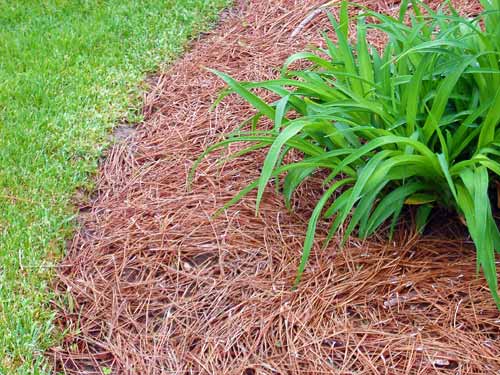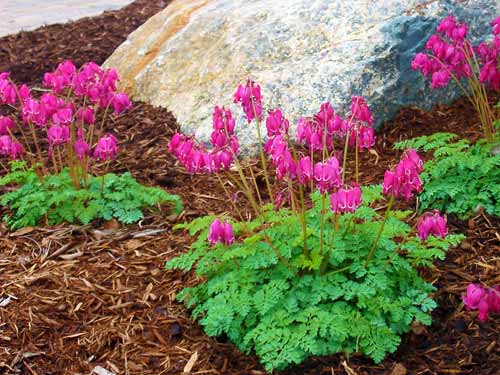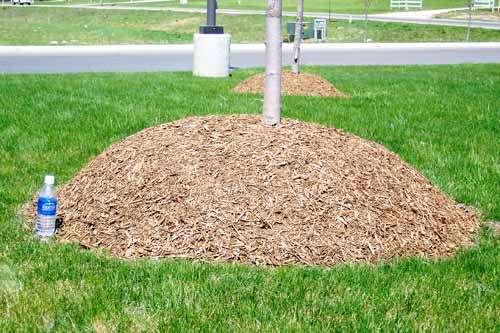Mulching landscape beds FAQs
As the weather warms and homeowners and landscapers become active, many questions begin to arise when it comes to mulching landscape beds.
Why mulch?
Mulch can provide a range of benefits for landscape beds. Here are just a few:
- Conserve soil moisture. Mulch reduces evaporation from the soil surface and helps to ensure that water reaches plant roots instead of going back into the atmosphere.
- Reduce soil temperatures. In a research trial in southwest Michigan, we found that 3 inches of wood chip mulch reduced midday soil temperature by 18 degrees Fahrenheit.
- Add organic matter. As mulch breaks down it adds organic matter to the soil, which aids in the soil’s ability to retain important plant nutrients such as potassium, magnesium, calcium and iron.
- Weed control. Mulch can help to control weeds, reducing the need for herbicides or hand-weeding.
- Appearance. Neatly applied mulch can improve contrast between beds and lawn, providing a cleaner-looking edge.
- Avoid lawn mower blight and string trimmer trauma. Providing a buffer between mowers and weed wackers reduces the likelihood of trunk damage to trees.


Left, Pine straw mulch. Right, Newly mulched perennial garden benefits by reduced weeding later in the summer and increased moisture retention. Take care not to apply mulch over the tops of plants. Photo credits: Rebecca Finneran, MSU Extension
How much mulch should I apply?
Deeper is not always better: 2 to 3 inches of mulch is adequate to get the maximum mulch benefit in most cases. If a site already has mulch from last year, a thin, 1-inch top-dressing is more than adequate. When mulching perennials in the landscape, take care not to spread mulch over the crown of the plants.

Never pile up mulch at the base of a woody plant, giving the “mulch volcano” effect.
Photo credit: Jeff Granger, MSU
What’s the best material to use for mulch?
To a large extent, the “best” mulch material is in the eye of the beholder. Most organic materials such as ground bark, ground wood chips or shredded leaves can provide the key benefits of moisture conservation, weed control, thermal insulation and organic matter addition. Therefore, cost, aesthetic appearance and availability are often the deciding factors. Inorganic mulches such as rock or shredded tires do not need to be replaced, but do not add organic matter to the soil.
What about lawn clippings as mulch?
Lawn clipping are a poor choice for mulch since they tend to mat together and impede water penetration if they dry out. In addition, they are unsightly and can produce an unpleasant odor as they decompose. Michigan State University Extension says a better alternative is to compost your lawn clippings and then use the compost in your garden or as a top-dressed amendment before you apply mulch. Or use a mulching mower that returns the clippings back into your yard.
Is it true that mulch can “tie-up” soil nutrients?
In theory, organic mulches that are low in nitrogen, such as wood chips, can reduce soil nitrogen availability during the process of microbial decomposition. In reality, we see little evidence of this in trees and shrubs. We monitored plant nitrogen in landscape shrubs and found no difference between plants without mulch and those that were mulched with pine, hardwood bark and wood chips. In fact, in a couple of instances, the mulched plants had increased plant nitrogen. The one case where nutrient tie-up could be a concern is with annual bedding plants since they have limited root systems.
Why are some environmental groups pushing for boycott of cypress mulch?
Most cypress mulch comes from trees harvested from wetland areas of Louisiana and Florida. Since these areas are prone to periodic flooding, cypress regeneration can be difficult, raising concerns about the sustainability of cypress harvesting. In Michigan, red pine bark and hardwood bark are ideal alternatives since there are by-products of our local timber industry.
Can cocoa mulch hurt dogs?
As many people are aware, there are chemicals in chocolate that can be poisonous to dogs. Husks from cocoa beans that are sold as mulch can also contain some of these chemicals. It is highly unlikely a pet could ingest enough to cause a serious problem, though some dogs with indiscriminant eating habits (presumably you know if you have one those) might consume enough to cause some vomiting or diarrhea. Bottom line, look for an alternative if your dog likes to eat first and ask questions later.
Dr. Cregg’s work is funded in part by MSU’s AgBioResearch.



 Print
Print Email
Email

